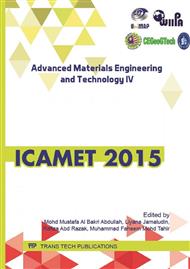[1]
Abdul Aziz, M.S., et al.: Simulation Modelling Practice and Theory. 57. (2015), pp.45-57.
Google Scholar
[2]
B. Lucheva, T.T., P. Iiliev: Journal of Minerals, Metals & Materials Society. 63. (2011), pp.18-22.
Google Scholar
[3]
B. S. Kim, J.C.L., H.S. Yoon S.K. Kim: Materials Transactions. 52. (2011), pp.1814-1817.
Google Scholar
[4]
C. Senol ., E.S.: International Journal of Mineral Processing. 110–111. (2012), pp.71-73.
Google Scholar
[5]
Chandrasekaran, S., Basak, T., and Srinivasan, R.: International Communications in Heat and Mass Transfer. 48. (2013), pp.22-27.
Google Scholar
[6]
H. Zoltan., K.T.: Materials Science and Engineering. 39. (2014), pp.13-22.
Google Scholar
[7]
H. Wang, X.X., X. Li, J. Zhang, C. Li: Rare Metals. 29. (2010), pp.355-360.
Google Scholar
[8]
Jeong, M.K.J.P.K.C. a.K.J. a.K.J. -C.L.V.K.J.: Waste Management. 32. (2012), p.1919-(1925).
Google Scholar
[9]
K. Yoo, J. -C.L., K. -S. Lee, B. -S. Kim, M. -S. Kim, S. -K. Kim and B. D. Pandey: Materials Transactions. 53. (2012), p. (2012).
Google Scholar
[10]
Kékesi, T., Török, T.I., and Kabelik, G.: Hydrometallurgy. 55. (2000), pp.213-222.
Google Scholar
[11]
M. Fang., C.H.L., L. Q. Huanga., H. X. Laia., J. Chena., J. T. Lia., W. H. Mab., P. F. Xingc.,X. T. Luo: Separation Science and Technology,. 49. (2014), p.2261–2270.
Google Scholar
[12]
T. Havlik., D.O., M. Petranikova., A. Miskufova: Waste Management. 31. (2011), pp.1542-1546.
DOI: 10.1016/j.wasman.2011.02.012
Google Scholar
[13]
Vijayaram R., N., ; Chandramohan K.: Research Journal of engineeering Science. 2. (2013), pp.11-14.
Google Scholar
[14]
Z. Dobo, T.K., T. Kekesi: Materials Science and Metallurgy Engineering. 37/2. (2012), pp.19-26.
Google Scholar
[15]
Z.X. Jing, L.N.J., Z. Xu, F. Yan, J. Lan: Transactions of Nonferrous Metals Society of China. 21. (2011), pp.2117-2121.
Google Scholar


